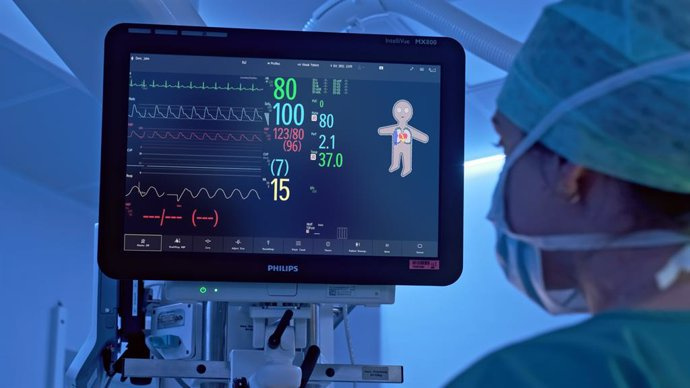(Information sent by the signatory company)
Madrid, February 12, 2024 – Royal Philips, a global leader in healthcare technology, has introduced new solutions in the latest IntelliVue patient monitoring software that improve the experience for patients and professionals. On the one hand, the Philips Sounds package that transforms the sound of care by reducing the noise of patient monitoring alarms by up to 66%, and the innovative Visual Patient Avatar, a pioneering solution in the use of patient data to make decisions. faster and more accurate decisions in the operating room at a glance.
Noise in hospitals can impact the quality of life and health of patients, their families and caregivers. In an average ICU, patient monitors account for up to 82% of alarm tones [1], with up to 350 alarms per patient per day [2]. "Throughout the process, we ask for feedback from care providers, administrators, patients and their families who are exposed to these alarms on a regular basis and leverage all of this data to help improve the experience," acknowledges Christoph Pedain, Business Director of Hospital Patient Monitoring at Philips.
Together, Philips and the SenSound sound design group worked to make alarm tones softer and more enveloping, and adjust alarm intervals to notify status or prompt action more gently, using a more relaxing set of alarm sounds. “The evolution of the sounds of our monitors has the potential to improve and change the soundscape in healthcare facilities around the world, helping to improve the environment for both patients and hospital staff,” says Frederic Martinez Sacchi, responsible for Connected Care at Philips Ibérica.
Avatar with contextual patient information
Emphasizing its aim to improve patient monitoring in hospitals, Philips has also announced the launch of Visual Patient Avatar, a revolutionary new monitoring solution that translates critical patient data into a simple visual design in the form of an avatar. easy to understand.
In today's operating rooms, lack of time and information overload contribute to poor situational awareness, responsible for 81.5% of anesthesia-related errors [3]. “In the past, operating room monitors displayed the patient's history through vital signs and numbers, which took time to interpret, which could affect the healthcare provider's ability to assimilate the information and make clinical decisions in a timely manner. ”says the head of Connected Care at Philips Ibérica.
In this sense, Visual Patient Avatar is designed to facilitate the interpretation of contextual information by visualizing physiological information in an innovative way through animations, colors and shapes. With a glance at a monitor, anesthesiologists and nurse anesthetists can recall and process critical data more quickly, efficiently and confidently. According to Christoph Pedain, “it helps professionals make timely decisions without losing their cognitive focus, they can prepare for what may come next, improving patient outcomes and saving lives.”
This solution was designed in collaboration with two doctors from the Display Technology Research Group at the Institute of Anesthesiology at the University Hospital Zurich, David Tscholl and Christoph Nöthiger. The inspiration for Visual Patient Avatar came from a shared hobby: flying airplanes. Doctors saw the benefits of applying a similar visual approach to patient monitors: “We had a vision to simplify the way critical information is presented in clinical settings and work with Philips to help bring this vision to bear and revolutionize attention," conclude Tscholl and Nöthiger.
References:
1] Cho, O. M., Kim, H., Lee, Y. W.,
[2] Jones K. (2014). Alarm fatigue a top patient safety hazard. CMAJ: Canadian Medical Association journal = journal of the Canadian Medical Association, 186(3), 178. https://doi.org/10.1503/cmaj.109-4696.
[3] Schulz et al. BMCA. 2016, Anesthesiology. 2017. MC Anesthesiol. 2016;16(14) doi: 10.1186/s12871-016-0172-7
Royal Philips (NYSE: PHG, AEX: PHI) is a leading health technology company, focused on improving people's health and well-being, and facilitating better results in the health cycle, from habits healthy and prevention, to diagnosis, treatment and home care. Philips leverages its advanced technology and deep clinical and consumer insights to deliver integrated solutions. Headquartered in the Netherlands, the company is a leader in diagnostic imaging, image-guided therapy, patient monitoring and health informatics, as well as consumer health and home care. Philips has recorded sales of €18.2 billion in 2023 and employs approximately 69,700 employees, with business operations and services in more than 100 countries. All news about Philips can be found in our News Center
For more information:
César García Requena
Brand
Philips Ibérica
Tel: 670 264 471
Email: cesar.garcia.requena@philips.com
Daniel Calvo
Europa Press Communication
Tel: 600 90 50 84
Email: danielcalvo@europapress.es













